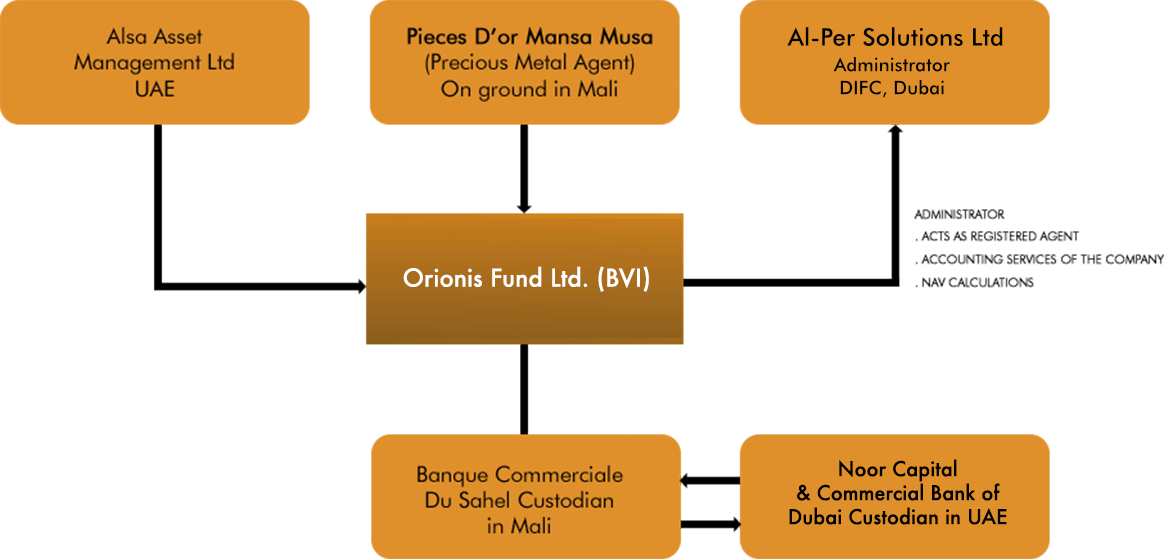Investment Details
Orionis Fund Ltd expects to distribute all capital gains and receipts, net of charges and will make distributions at the end of each cycle for the foreseeable future. Orionis Fund reserves the rights to change this policy.
INVESTMENT OBJECTIVE
The objective of the Company is to achieve maximum capital appreciation by investing and trading actively in raw gold / dore bars obtained from Artisanal Gold Mining. The Fund does not have a specific target for the investments, but carries out active opportunistic purchasing of raw gold with the lowest possible purchase price in order to maximize the potential returns on the investments.

INVESTMENT STRATEGY
The Fund will source and buy raw gold or gold dust and nuggets after analysis and selection on the advice of the Precious Metal Agent which comprises a professional team of experts well experienced in the purchase, and valuation, of gold. The raw gold collected will be then converted into a dore bar and sold as dore bars to either the wholesale retail or investor market or brought to the UAE and sold further to refineries in the UAE. All the above processes, in particular the purchase and sale of raw gold , will comply with the conflict free gold standard.
By surrounding itself with high quality professionals across every step of the purchase and sale cycle the Fund is willing to restrict some of its profit potential in exchange for security of purchase, and resale with the leading companies in the business. The Fund will only invest in raw gold and will not diversify outside of this field of expertise.

SUITABILITY
The fund targets professional investors who are experienced enough to understand the merits and risks on any potential investment of similiar nature.

Investment Type
Orionis Fund Limited is recognised as a professional mutual fund as per BVI Securities and Investment Business Act, 2010 (“SIBA”).
The investment offered is 2,000,000 Class G Preference Shares of Orionis Fund Ltd.
Investment Objective
The Fund will source and buy raw gold or gold dust and nuggets after analysis and selection on the advice of the Precious Metal Agent which comprises a professional team of experts well experienced in the purchase, and valuation, of gold. The raw gold collected will be then converted into a dore bar and sold as dore bars to either the wholesale retail or investor market or brought to the UAE and sold further to refineries in the UAE. All the above processes, in particular the purchase and sale of raw gold , will comply with the conflict free gold standard.
Investment Horizon
The Fund will only invest in raw gold and will not diversify outside of this field of expertise. Should the fund not be presented with enough raw gold of sufficient quality, the Fund will not attempt to change its criteria to utilize the funds in question and the Fund will remain focused on ensuring that only product of the required criteria are purchased.
Why Gold
Gold falls under the classification of ‘precious metals’ and is one among the most popular investment vehicles. Several factors continuously account for continuous demand of Gold investments including :
A History of Holding Its Value :-
Unlike paper currency, coins or other assets, gold has maintained its value throughout the ages. People see gold as a way to pass on and preserve their wealth from one generation to the next.
Weakness of the U.S. Dollar :-
Although the U.S. dollar is one of the world's most important reserve currencies, when the value of the dollar falls against other currencies as it did between 1998 and 2008, this often prompts people to flock to the security of gold, which raises gold prices . The price of gold nearly tripled between 1998 and 2008, reaching the $1,000-an-ounce milestone in early 2008 and nearly doubling between 2008 and 2012, hitting around the $1800-$1900 mark. The decline in the U.S. dollar occurred for a number of reasons, including the country's large budget and trade deficits and a large increase in the money supply.
Inflation :-
Gold has historically been an excellent hedge against inflation, because its price tends to rise when the cost of living increases. Over the past 50 years investors have seen gold prices soar and the stock market plunge during high-inflation years.
Deflation :-
Deflation, a period in which prices decrease, business activity slows and the economy is burdened by excessive debt, has not been seen globally since the Great Depression of the 1930s. During that time, the relative purchasing power of gold soared while other prices dropped sharply.
Gold retains its value not only in times of financial uncertainty, but in times of geopolitical uncertainty. It is often called the "crisis commodity," because people flee to its relative safety when world tensions rise; during such times, it often outperforms other investments. For example, gold prices experienced some major price movements this year in response to the crisis occurring in the European Union. Its price often rises the most when confidence in governments is low.
Supply Constraints :-
Much of the supply of gold in the market since the 1990s has come from sales of gold bullion from the vaults of global central banks. This selling by global central banks slowed greatly in 2008. At the same time, production of new gold from mines had been declining since 2000. Note it can take from five to 10 years to bring a new mine into production. As a general rule, reduction in the supply of gold increases gold prices.
Increasing Demand :-
In previous years, increased wealth of emerging market economies boosted demand for gold. In many of these countries, gold is intertwined into the culture. India is one of the largest gold-consuming nations in the world; it has many uses there, including jewelry. As such, the Indian wedding season in October is traditionally the time of the year that sees the highest global demand for gold (though it has taken a tumble in 2012.) In China, where gold bars are a traditional form of saving, the demand for gold has been steadfast.
Demand for gold has also grown among investors. Many are beginning to see commodities, particularly gold, as an investment class into which funds should be allocated. In fact, SPDR Gold Trust, became one of the largest ETFs in the U.S., as well as one of the world's largest holders of gold bullion in 2008, only four years after its inception.
Portfolio Diversification :-
The key to diversification is finding investments that are not closely correlated to one another; gold has historically had a negative correlation to stocks and other financial instruments. Recent history bears this out:
• The 1970s was great for gold, but terrible for stocks.
• The 1980s and 1990s were wonderful for stocks, but horrible for gold.
• 2008 saw stocks drop substantially as consumers migrated to gold.
Properly diversified investors combine gold with stocks and bonds in a portfolio to reduce the overall volatility and risk.
The Bottom Line :-
Gold should be an important part of a diversified investment portfolio because its price increases in response to events that cause the value of paper investments, such as stocks and bonds, to decline. Although the price of gold can be volatile in the short term, it has always maintained its value over the long term. Through the years, it has served as a hedge against inflation and the erosion of major currencies, and hence forms the basis of CIS.
Eligibility
Both individual and corporates are eligible with restriction to any US person and prohibited persons detailed in the Private Placement Memorandum.
Premium Type
Single Investments noting additional investments are permitted.
Minimum Investment
US$1,000,000 or AED equivalent.
Additional Investment
Minimum multiples of US$500,000 or AED equivalent.
Entry Load
A subscription fee of up to 5% of the subscription is applicable. However, this may be waived by the Directors of the company in their sole discretion.
Exit Load
Not applicable.
Lock in Period
The Fund aims for long term investors and doesn't stipulate a lock in period. Further, fund offers the flexibility to exit as per the predefined 'Redemption Terms' detailed in the Private Placement Memorandum.
Subscription Period
Open ended continuous private offering of Class G Preference Shares.
Redemption Terms
An investor may redeem his investments fully or partially at the redemption price (NAV) as of the last day of each month by written notice to the Administrator. Unless the Company agrees otherwise in any case, a notice period of not less than twenty (20) business days will be required in all cases. Any notice of redemption received after 3.00pm (BVI time) on any day will be treated as being received on the next business day”.
Investment Allocation
By allocating preference shares of the company by considering the equivalent investment units as per net asset value (NAV) of the company.
The Net Asset Value of Class G Preference Shares is determined as of the last business day of each month in US Dollars (in respect of the US$ Preference Shares) and is equal to its assets less its liabilities determined in accordance with generally accepted accounting principles in the United Kingdom, including any unrealised profits and losses on its open positions. More specifically, the Net Asset Value of the Company is equal to the sum of all cash, cash equivalents, the liquidating value (or cost of liquidation, as the case may be) of all futures and options positions and the fair value of all other assets of the Company, less all liabilities (such as brokerage commissions and fees) of the Company (including accrued liabilities, irrespective of whether such liabilities may in fact never be paid), in each case as determined in the British Virgin Islands by the Administrator in accordance with generally accepted accounting principles in the United Kingdom.
Communications to Investors
Communications to investors (including copies of the company's annual and quarterly reports and of the audited financial statements) will be mailed to investors at their respective registered addresses as recorded in the books and the records of the company.
Risk / Reward
All potential investors to read the private placement memorandum prior to investing and also if necessary should consult your financial advisors prior to undertaking any investments in the company.
GLOBALLY
-
The artisanal and small-scale gold mining sector is responsible for 20% of annual gold production globally.
-
Over 400 tons emerging from over 70 nations.
-
This represents a value of approximately $20B and a work force of 15 million miners.
MALI
-
The artisanal and small scale gold mining sector is responsible for 30% of the annual gold production in Mali. A work force of approx. 4 million

| 2016 | 2015 | 2014 | |
|---|---|---|---|
| Industrial | 47 T | 46 T | 45.5 T |
| Artisanal and small scale | 20 T | 24 T | 7.4 T |
| Total | 67 T | 70 T | 53.2 T |
Potential in Mali
-
Mali has over 1.2 million km² of various geological terrains with potential mineral resources:
-
Proven gold reserves determined, as of 2015, to be at least 600 tons OR 21.16 million Oz
-
Majority of mines are located in the southern part of the country
-
The country has exported, on average 50 tons annually over the past decade
-
The most promising potential reserves are in the
Regions Yatela Kodieran Tobakoto Loulo Segala Kalana Tonnage 40 T 80 T 60 T 64 T 40 T 40 T -
The Kodieran mines owned by Wassoul’Or covers a 100 Km² Deposits are often situated from the surface down,
which allows cost-efficient mining methods without deep drilling and blasting -
The Kodieran mines have proven recoverable reserves of 1.75 million ounces as per the international standard NI 43-101
-
Work in the gold field is well organised, all work is done by teamwork and proceeds in an orderly fashion
01. Penetration of Crust: The first step in gold extraction process. The team works until they reach the vein. From here work is taken over by the pitworkers, miners & washers.
02. Extraction and deep washing (working in the tunnel): This is essentially tunnel work followed by the delicate gold extraction process. These miners/diggers have more stamina as this step demands more physical effort. The underground work is very hard and these workers are dealing with more risk and danger hence, this step requires more experience and a great carefulness
03. Lifting and Processing of the Ore: Processing of the ore consists washing except when gold is present in hard matter. Much of the lifting is undertaken by women with rope and buckets.
Usually women wash the ore in a small pool or some even prefer to transport it on their heads to the nearest stream/river and wash the ore. These women possess calabashes and pans. When washing the ore in order to facilitate the process, women mix some soap in the water which can help them to separate gold from unwanted gangue materials.
Orionis Fund Limited-INTRODUCTION
-
From 1996 to date (22 years), Pieces D’or Mansa Mussa, SA and Mr. Al Sayegh , have been active in the field, working with locals and the Government of Mali to develop the informal artisanal mining sector
-
The gold is mined from the Kodieran deposits, located in south Mali near the Senegalese border.
-
The Kodieran mines have proven recoverable reserves of 1.75 million ounces.
-
Valuable information gathered over the past 22 years has been implemented to optimise utilization of gold mining resources for gold recovery keeping in mind
-
The protection of the environment
-
No support to armed groups or corrupt practices
-
Conditions in the mines are free of forced labour and child labour
-

TRANSACTION STAGES AND PROCESS
-
The entire Transaction from commencement to completion includes each of the following stages:
01. Client money: Client money is deposited into the Custodian bank account at Commercial Bank of Dubai, from there at the instruction of the Investment advisor/manager the money is sent to the Orionis Bank account in Mali held with Banque Commerciale Du Sahel a local Bank
02. Collection: Collection of gold dust or nuggets on the concession is transacted by the local precious metal agent for which the digger/miner is paid 50% of the price by reference to the prevailing LBMA spot price. The above transaction is carried on with a number of diggers/miners on the concession on a daily basis. At the end of the month the miners are paid the remainder of money owed to them.
03. Transportation & Bailment: When a bailment batch is reached, the bailment batch is transported under secure transport to the Precious Metal Agents Vault in Bamako, Mali.
04. Refining into Dore bars:Once bailment is reached the local Precious metal agent consolidates the bailments into batches of Dore bars listing the fine ounces contained in each bar. After which they are sold in the local market or stored in a secure vault to be transported to Dubai refiners for smelting into 99.999% gold bars.
INVESTMENT PROCESS

Key Attributes of the Collective Investment Scheme
-
The Fund's assets (i.e. gold from the mine) are isolated from systemic risk and vaulted with private (non-bank) vaulting providers. This assures that the Fund retains the highest options for liquidity yet protects the Fund's assets from loss in the event of bank failures.
-
The Fund has successfully decoupled it self from the volatility of the price of gold
-
The Fund leverages its direct relationships with one of the largest mines in Mali for delivery to refineries in the UAE to ensure supply of gold as well as providing access to a global pool of liquidity.
-
Shares of the CIS/Fund are redeemable upon a 30-day redemption notice.
-
The CIS/Fund pays monthly cash dividends.
